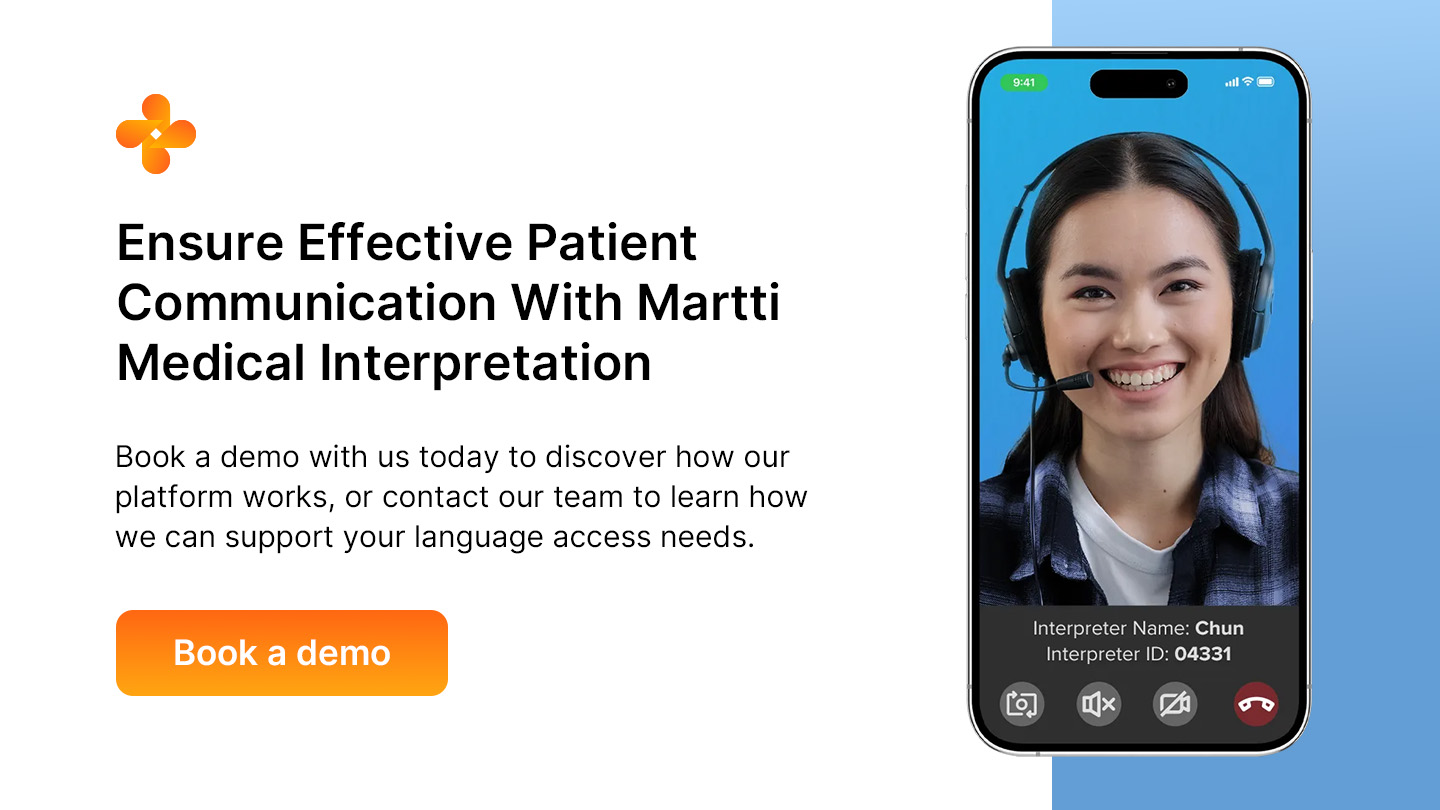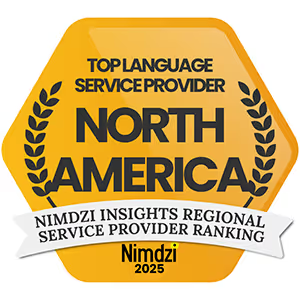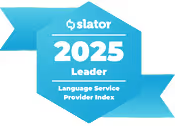Communication is the cornerstone of quality healthcare. When patients and providers cannot communicate effectively due to language barriers, it can impact patient safety, satisfaction, and outcomes.
Fortunately, medical translators and medical interpreters bridge the communication gap in healthcare. Both professions facilitate understanding between patients and providers who do not share a language. However, they serve distinct purposes and require vastly different skills.
This article explores the role of a medical or healthcare interpreter versus translator. We highlight the key differences between the two and how each profession contributes to better healthcare delivery.
What Is a Medical Interpreter?
A medical interpreter supports communicative autonomy by facilitating oral or signed communication between patients and healthcare providers who use different languages. They interpret spoken or signed language in real time, accurately conveying messages from one language to another.
Medical interpreters mainly work in the following modes:
- Simultaneous interpreting: Interpreting as the speaker talks, with only a slight delay
- Consecutive interpreting: Waiting for a pause to relay what was said or signed
A medical interpreter ensures that critical information is communicated accurately and immediately during medical encounters. This interpretation is especially fundamental in high-stakes situations such as emergency care, surgical consents, and complex diagnoses.
In addition to oral or signed language skills, medical interpreters require a deep understanding of medical terminology, ethical principles, and cultural nuances. In the U.S., they also follow specific protocols to adhere to the national code of ethics and standards of practice for interpreters in health care (NCIHC, 2004 and 2005). They render information in at least two languages, using their linguistic and cultural expertise to facilitate accurate, meaningful, culturally sensitive communication.

What Is a Medical Translator?
A medical translator converts written healthcare-related content from one language to another. They work with many documents, including the following:
- Patient records
- Consent forms
- Discharge instructions
- Medical reports
- Educational materials
A medical translator ensures that the translated content accurately conveys the meaning and intent of the original text while maintaining cultural appropriateness and adhering to medical terminology. They require linguistic expertise, mostly written, a deep understanding of the subject matter, and an understanding of complex medical concepts.
Various situations require medical translation services, such as the following:
- Translating a patient's medical history from their native language
- Preparing multilingual consent forms for clinical trials
- Localizing patient education brochures for diverse populations
- Translating research papers for international publication
While medical translators often work behind the scenes, their work is vital to ensure important health information is accessible and understandable to the reader, regardless of their language proficiency.
Comparing a Medical Interpreter vs. Medical Translator
Both medical interpreters and translators are critical in healthcare communication. However, there are significant differences between the two professions. Here is a comparison of medical translation versus medical interpretation in five main areas.
1. Mode of Communication
Medical interpreters work with spoken or signed language. They enable real-time oral or signed communication between parties who do not share a language. They must be able to sign or listen and speak fluently, quickly processing and conveying information in both directions.
Conversely, translators work with written text. They convert written materials from a source language to a target language, focusing on accuracy, clarity, and cultural appropriateness.
Fun fact: In each translation, the source and target language are the same. In an interpreted session, the source and target language switch every time each party communicates.
2. Context of Work
Medical interpreters and translators work in different environments. Interpreters often work in real time, facilitating live communication during healthcare encounters. They work either onsite or remotely via phone or video, providing immediate language support for hospitals, clinics, and doctors' offices. They must be comfortable working in fast-paced, high-pressure situations and interacting with patients and providers from diverse backgrounds. Many remote interpreting interactions are now subject to monitoring and evaluation as part of a quality assurance program. Onsite interpreting sessions are more difficult to monitor but more and more interpreting programs are adding this important aspect to ensure high quality, accurate interpretation.
Translators work after the fact or in advance and do not have to translate in real time. They work with written records of the appointment, lecture, diagnosis, conference, or research. So, they can take time to research, double-check, and correct their work. After a piece is translated, they go through an editing process to ensure that the content is accurate and complete before it’s delivered. Part of the translation and editing process involves communication with the requester to ensure that the content includes local and organization-specific nuances.
Fun fact: Interpreters specialize in talking; translators inwriting.
3. Skills and Training Required
Medical interpreters need the following skills:
- Excellent signing or listening and speaking skills
- The ability to quickly receive, process and convey information
- Strong interpersonal skills
- Message transfer, session preparation and management, assertiveness, and problem solving
- Cultural sensitivity
- Ability to maintain confidentiality and impartiality
Translators require exceptional writing and editing skills. They must be able to do the following:
- Understand complex medical concepts
- Have strong language proficiency, excellent writing abilities, cultural awareness, research skills
- Ability to use databases, glossaries, and computer-assisted translation (CAT) tools
- Convey information clearly and accurately in writing
- Ensure cultural and linguistic appropriateness
- Adhere to specific formatting and style requirements
Both professions require specialized training in skills, protocols, medical terminology, and ethics
4. Interaction With Patients and Providers
Medical interpreters have direct interaction with patients and providers, acting as an immediate bridge between parties who do not share a language. They facilitate communication in real time, often in emotionally charged situations such as delivering a diagnosis or discussing treatment options. Medical interpreters require a high level of empathy, cultural sensitivity, and the ability to maintain composure, professionalism, and role boundaries.
Medical translators usually do not have direct contact with patients or providers; they typically interact with requesters who are administrators. Their work enables effective communication through the translation of written materials, but they do not participate in real-time interactions with consumers of the translated materials.
5. Impact on Patient Care
Interpreters directly influence the quality of care. They ensure that patients can communicate their needs and concerns and they allow providers to gather accurate information and provide clear instructions. Their services result in the following:
- Better patient understanding and adherence to treatment plans
- Increased patient satisfaction
- Reduced risk of medical errors
Translators support patient care by making important health information accessible to patients in their preferred language. Accurate and culturally appropriate translations of documents, such as consent forms, discharge instructions, medication labels, and educational materials, can help patients better understand and manage their health.
Why Trust Us for Medical Interpretation Services?
When it comes to medical interpretation services, Martti is a trusted industry leader. With over 20 years of experience providing language access solutions to healthcare organizations, we have the expertise and technology to facilitate effective communication between patients and providers. Our medical interpreters are highly trained and certified, with a deep understanding of healthcare terminology and cultural nuances.
We offer video remote and over-the-phone interpretation in more than 250 languages, including American Sign Language, ensuring patients can communicate in their preferred language. Martti's innovative platform integrates seamlessly with electronic health record systems, enabling providers to access interpreter services quickly and easily. Our expertise in language access and its importance in health equity comes from our commitment to quality, compliance, and patient satisfaction.
Ensure Effective Patient Communication with Martti Medical Interpretation
Medical interpreters and translators play distinct but equally important roles in breaking down language barriers in healthcare. At Martti, we understand the critical importance of effective communication in providing quality care. Our medical interpretation services allow providers to communicate clearly with patients, regardless of language differences.
By partnering with Martti, your healthcare organization can enhance patient experience, improve outcomes, reduce risks, and ensure compliance with language access regulations. Book a demo with us today to discover how our platform works or contact our team to learn how we can support your language access needs. We look forward to working with you.

Linked sources:









